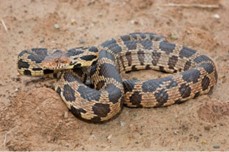Common Gartersnake
As their name suggests, this species is Wisconsin’s most abundant snake. They are found in every county of the state and nearly every habitat type, although they have a preference for forest and woodlot edges and rely heavily on open canopy wetlands for overwintering.
They may occasionally be found communally “denning” in very large numbers. Females are generally much longer than males and may occasionally exceed 30″ in length. Common gartersnakes look much like other gartersnakes except that their lateral stripes only involve scale rows 1, 2 and 3. Their diet includes frogs, toads, salamanders, fish, earthworms and insects.

Eastern Foxsnake
The foxsnake has many large reddish-brown, chocolate brown or black mid-dorsal blotches along its back and other smaller blotches on its sides on a background color of yellow, tan or olive-gray. The head of adults is usually a dark copper, rust or orange color. They live in a variety of open habitats including marshes, sedge meadows, prairies and old fields.
Their diet consists primarily of rodents and ground-nesting birds. Young foxsnakes will occasionally eat amphibians. This species is the most frequently encountered snake in people’s homes, especially if the house has an old rock foundation where the snake(s) may be hunting for food or hibernating in the basement. The foxsnake is often mistaken for the venomous copperhead due to its head color and subsequently is often killed. Copperheads do not live in or near Wisconsin. Foxsnakes are also often mistaken for rattlesnakes, as they often “rattle” their tails in dry leaves, grasses or against objects when disturbed. Their pointed tail distinguishes them (and all other Wisconsin snakes with pointed tails) as a non-venomous species in Wisconsin.
